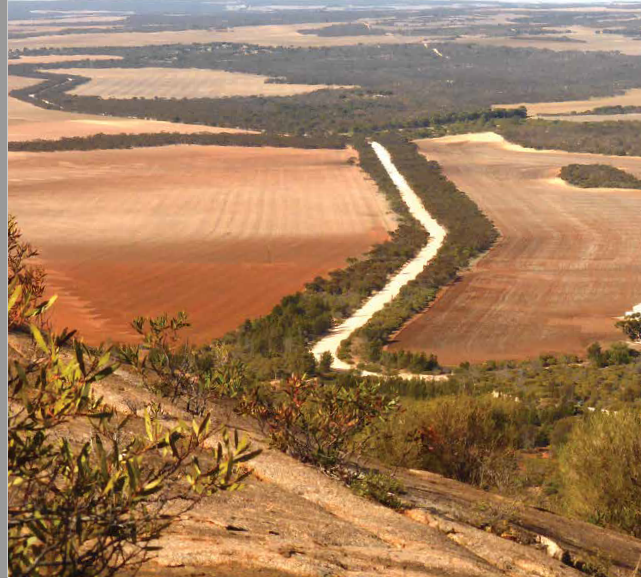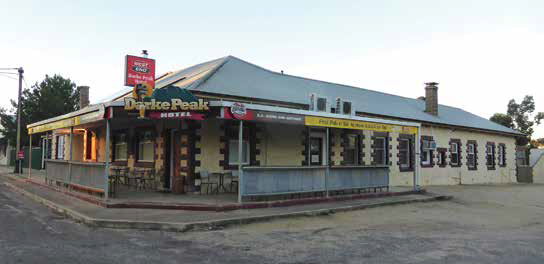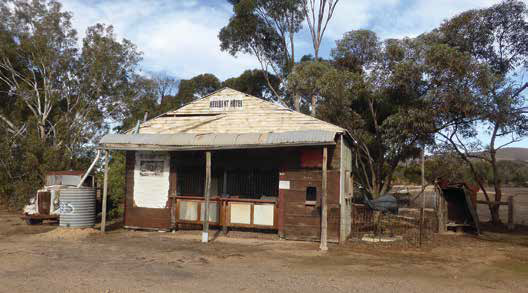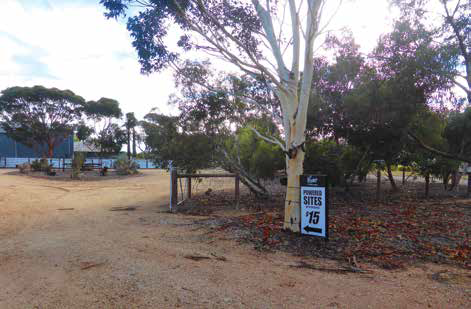
The panoramic view from Carappee Hill
Sometimes in your travels, chance leads you along the road to a little spot that wiggles its way unexpectedly into your fondest memories. It can be almost impossible to pinpoint what is so endearing about these places.
We have often crossed the Nullarbor and near Kimba at the top of the Eyre Peninsula in South Australia, halfway across Australia, passed the turnoff to Darke Peak and continued on to destinations further east. But this trip our travelling companions decided we should follow that sign to satisfy their longstanding curiosity as to where it led. The place is hardly a town (population about 17) – just a pub, grain silos, a few houses and a railway line that is no longer in use. Behind the pub, hosts Alan and Annie have provided a welcoming and well-maintained campground, with power, water, fire ring, toilets and shower and even a patch of lush green lawn. Meals are available in the dining room and our garfish was delicious. The night we visited the bar we were greeted by all the local drinkers, curious to know about our travels and to share stories of their district, along with the ever-present talk about the prospect of rain and the state of crop seeding. And it was probably this friendliness that was the key to our feeling so welcome here.
The nearest towns are 50 kilometres away and so the locals are used to making their own fun and this is evident in the story of the Hellbent Hotel, across the road from the pub. This began as a ramshackle construction when the drinkers at the pub decided sometime after midnight on New Year’s Eve 1979 that it would be a good idea to build their own bar so they could continue drinking after the pub shut. An assortment of building materials and scraps were gathered and as the sun rose on 1980, the legend of the Hellbent Hotel was born. In 2009, when the town held a Legends Festival, it was decided that the original escapade deserved recognition, along with the various local sporting and community figures, and a new, more substantial structure was completed. One of the features of the new ‘hotel’ is a sculpture of Erica the emu, which was a fixture around the local golf course and in the bar, where it was known to swallow any loose change left on the bar and even the customers’ cigarettes. The metal sculpture by Cleve farmer Peter ‘Turtle’ Crosby is made with scraps of farm machinery – the feathers are the combs of a grain harvester, the feet are ploughshares, and the neck feathers are from shears.

Darke Peak Hotel
DARKE DISTINCTION
The campground proved a good base to explore the many interesting sights nearby. First was a drive out to the grave of John Charles Darke, the first European explorer and surveyor in the district. He had been returning from an unsuccessful expedition beyond the Gawler Ranges in search of good agricultural lands, when, a little further north at Waddikee Rocks, he was speared by aborigines who had earlier appeared friendly and had led the men to a waterhole. He died the following day and was buried at the foot of the peak which now bears his name. Continuing on the same route, we came to Federation Hill Lookout and water tank at the southern end of the range. This provided some spectacular views of the countryside. At this time of the season and after several years of poor rains, it was a brown landscape but farmers had begun to plant their crops and you could picture it greening up quickly with some follow-up rains. There is a four-wheel drive track across the top of this range but it is rough and rocky and the 14 kilometres can take up to two and a half hours so we did not tackle it.
The other must-do here is to climb Carappee Hill to the east of the town. At 497 metres, it is the highest point on the Eyre Peninsula, the second largest monolith and the most extensive granite rock in South Australia. The climb to the top is of moderate difficulty following the painted white dots and arrows, scrambling over loose rocky sections, expanses of bare granite and through patches of close scrub. The sign at the entrance indicated the trip required two hours return but we three seniors took nearly three hours. At the top there is a visitors’ book to record your achievement and for those into geocaching there is also a cache to be found. We enjoyed the views from here over the farmland and back to the silos in Darke Peak. And there at eye level were two great wedge-tailed eagles just cruising on the thermals and, like us, enjoying the warm autumn afternoon sun. We saw evidence of echidna diggings but the animals were not to be seen. The area is also known as a good place for a bit of native orchid and wildflower spotting in good seasons.
As our stay extended to its third day, we took a day trip to Cleve, a bigger service town for the surrounding farming district. This is another place where friendliness seems to be compulsory. A local tip-off led us to another of Peter Crosby’s metal sculptures, Clyde, the Clydesdale horse, with his little metal lizard mate and a quirky and amusing sign explaining how they came into being. They are on display in a front yard on Golf Road. The artist has been asked why he did not put them in the main street but he said that being where they are encourages visitors to get around and see more of the town. There is a Heritage Trail around the town with signage giving interesting information about the many historic buildings, and there is also plenty of public art and murals. The Birdseye Bus Stop is worth a look – it tells the story of Sylvia Birdseye, a legendary character who helped pioneer transportation in the area. The highway across the peninsula from Cowell to Cleve, Lock and Elliston is named in her honour.
Cleve is a community which welcomes RV travellers, with camping at the showground in town, wide streets and easy parking. About five kilometres out of town along Cleve Hills Scenic Drive, there is the Yeldulknie Weir which had been part of a grand scheme to provide water to the Eyre Peninsula. It is no longer used for that purpose and when we visited was sadly almost empty. However, below the wall there is an excellent camping area maintained by the local Lions Club. This was as well-appointed and thoughtfully laid-out as any we have seen and would make a quiet base to explore from. Be sure to show your appreciation by dropping some money into the donation box.

The legend of the Hellbent Hotel was born in 1980
CONVIVIAL CUMMINS
There is so much to be seen in this area that visitors could easily allow for a stay of a week or more. Then, still staying away from the coast, you could venture further down the Tod Highway from Lock to the town of Cummins. This has to be the home of the friendliest people in the country. Everyone in the street greeted us as we made our way to the well-stocked Five Loaves Bakery – which sells the best vanilla slice in Australia by our reckoning. Perhaps it is because the town has Cummins Mill, the only flour mill on the peninsula. Visitors can call in and buy flour and bread mixes knowing that all the grains are sourced from local farmers. They have helpful recipes too (https://cumminsmill.com.au). For those who like to find the quirky and unusual in their travels, be sure to visit the public toilets in the Railway Triangle. The mosaic decorated loos won the award in the 2018 International Toilet Tourism Awards for the Best Economic Contributor, showing that good public conveniences are important in encouraging travellers to stay a while and spend more than a penny in this small town which is not really on the main tourist route. Well done Cummins community.
While on the Lower Eyre Peninsula inland tour, we visited the fascinating and extensive Koppio Smithy Museum, a 20-minute drive from Cummins. This National Trust property is based on a 1903 blacksmith shop and cottage but many more old buildings have been relocated here, along with agricultural machinery and vehicles, household goods and the memorabilia of local pioneering families. There are so many of these little museums in country towns everywhere but this one was more extensive than most. We can all recognise the Rinso laundry powder box and the blue bags, the meat mincer and ice chest, the cream separator and butter churn, the school work and the local show prizes in most of these places, but what set this one apart for us was the Bob Dobbins barbed wire and fencing collection. Who would have thought this could be so interesting? It is one of only three dedicated barbed wire museum collections in the world. It displays so many different types of barbed wire with different origins and uses including pieces from prisoner of war camps and the Berlin Wall – even a piece found on Mt Everest.

Darke Peak camping ground
All these inland districts do not see tourists in the same numbers that travel around the Eyre Coast on the Flinders and Lincoln Highways, or those who cross the Nullarbor and drive by that turn-off sign to Darke Peak near Kimba. But that can be the main attraction for those of us who prefer to be off the beaten track. So next time, follow the sign and let some of these little places work their way into your memory collection.
Category: Unknown
Written: Thu 01 Aug 2019
Printed: August, 2019
Published By:
LYN BEARD W98399